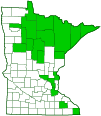Hunchback bee fly
(Lepidophora lutea)
Conservation • Description • Habitat • Ecology • Distribution • Taxonomy
Conservation Status |
|||
| IUCN Red List | not listed |
||
| NatureServe | NNR - Unranked |
||
| Minnesota | not listed |
||
Description |
Hunchback bee fly is a medium-sized bee fly with a distinctly hunch-backed appearance. It is a mimic of a robber fly. The beak (proboscis) is extended. The thorax is densely covered with yellow hair-like scales except in three longitudinal, black stripes. It does not have long, curved, bristle-like hairs. The sides of the first four abdominal segments (A1–A4) are covered with yellow scales. A5 has black scales above and white, yellowish-white, or yellow scales on the side. A6–A8 are covered with black scales. A9–A10 are part of the external genitalia. The wings have dark but faint patterns. They are held outstretched and swept back at rest. The first branch of the terminal fork of the median vein is behind the wing tip. The legs are slender. |
Size |
|
Similar Species |
Scaly bee fly (Lepidophora lepidocera) usually has no pale scales on the sides of the fourth abdominal segment. There is a distinct fringe at the end of the abdomen. |
Habitat |
|
Ecology |
Season |
July to September |
Behavior |
|
Life Cycle |
|
Larva Food |
Larvae eat the collected food and/or the larvae of solitary wasps. |
Adult Food |
Flower nectar |
Distribution |
||
|
Sources |
|
| 9/13/2025 | ||
Occurrence |
||
|
||
Taxonomy |
|
Order |
|
Suborder |
Brachycera |
Infraorder |
Orthorrhapha |
Superfamily |
Asiloidea |
Family |
Bombyliidae (bee flies) |
Subfamily |
Bombyliinae / Ecliminae |
Tribe |
Eclimini |
Genus |
Lepidophora |
Subfamily |
|
Subordinate Taxa |
|
|
|
Synonyms |
|
|
|
Common Names |
|
hunchback bee fly |
|
Visitor Photos
Share your photo of this insect.
This button not working for you?
Simply email us at info@MinnesotaSeasons.com.
Attach one or more photos and, if you like, a caption.
David Schaffhausen |
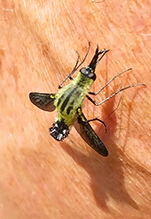 |
Awesome fly, my 1st sighting! 💛 |
Alfredo Colon |
||
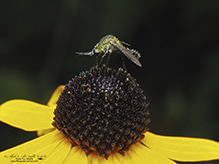 |
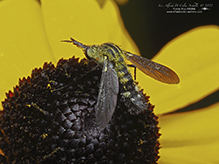 |
|
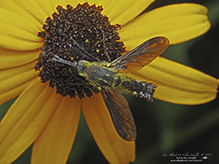 |
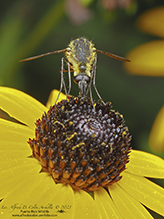 |
|
J Allan Zimmer |
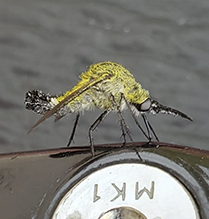 |
Linda Griggs |
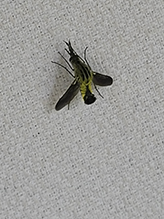 |
Jackie Wilson |
||
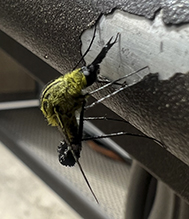 |
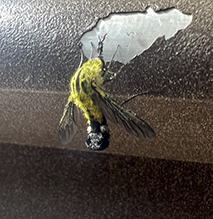 |
|
Mike Poeppe |
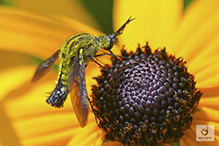 |
Penny Milkey |
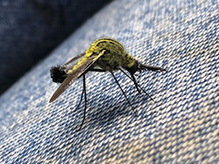 |
very cool to see this and to be able to identify it based on your photo. |
Janet Gouvas |
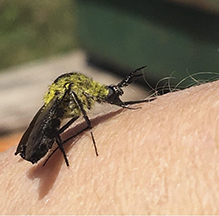 |
Mike Bergquist |
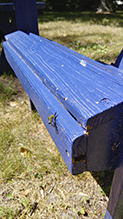 |
A very unusual insect! |
Luciearl |
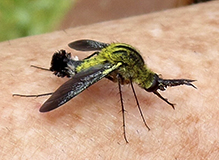 |
This little critter landed on my arm as I was watering. He stayed for quite awhile licking my arm with that tiny forked "tongue". Whether it was a few water droplets or salt, he stayed on my arm for quite awhile and was able to call for my husband to "GET MY CAMERA"!! |
Barnes |
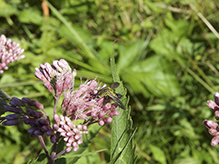 |
Bill Reynolds |
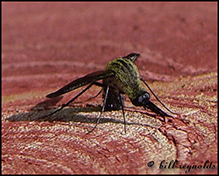 |
MinnesotaSeasons.com Photos
|

Slideshows

Visitor Videos
Share your video of this insect.
This button not working for you?
Simply email us at info@MinnesotaSeasons.com.
Attach a video, a YouTube link, or a cloud storage link.
David Schaffhausen
hunchback bee fly 01
Sep 13, 2025
Penny Milkey
hunchback bee fly 01
Aug 13, 2020
Other Videos

Visitor Sightings
Report a sighting of this insect.
This button not working for you?
Simply email us at info@MinnesotaSeasons.com.
Be sure to include a location.
Penny Milkey
8/12/2020
Location: Lake Linden, MI
very cool to see this and to be able to identify it based on your photo. I have video and pics if you’d like them.
Mike Bergquist
8/6/2019
Location: 5 miles west of Pennington, MN in Beltrami County.
A very unusual insect!
Luciearl
8/12/2018
Location: Lake Shore, MN
This little critter landed on my arm as I was watering. He stayed for quite awhile licking my arm with that tiny forked "tongue". Whether it was a few water droplets or salt, he stayed on my arm for quite awhile and was able to call for my husband to "GET MY CAMERA"!!
MinnesotaSeasons.com Sightings

